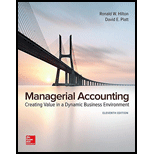
1.
Calculate the contribution margin ratio of touring model for A T S Company.
1.
Explanation of Solution
Contribution Margin: It is defined as the difference between the sales and the variable cost. In other words, contribution margin is the excess amount of sales revenue after deducting variable expenses.
The formula to calculate contribution margin is as follows:
Contribution Margin ratio: It is a ratio that measures the contribution margin generated by the company from the sales to make it avialable for paying the fixed cost and generate a profit. It is expressed as percentage of margin available from each dollar sales to pay fixed expenses and to provide profit.
The formula to calculate the contribution margin ratio is as follows:
Calculate the contribution margin ratio.
Working note:
Calculate the contribution margin.
2.
Calculate the sales volume (in units) to attain after- tax net income of $22,080.
2.
Explanation of Solution
Target Profit: It refers to the desired amount of profit that a company expects to achieve by the end of an accounting period after it reaches its break-even point. Thus, the company needs to compute the required sales to earn the target profit.
Calculate the sales volume (in units).
3.
Calculate the variable cost per unit of the touring model to change that have the same break-even point as mountaineering model.
3.
Explanation of Solution
Break-even Point: It refers to a point in the level of operations at which a company experiences its revenues generated is equal to its costs incurred. Thus, when a company reaches at its break-even point, it reports neither an income nor a loss from operations.
The formula to calculate the break-even point in sales units is as follows:
Variable cost: A variable cost is the cost that proportionately changes with the changes in the activity base such as units of production.
Calculate the break-even point (in units) for mountaineering model.
Working note:
Calculate the contribution per unit.
Let assume Y denotes the variable cost of the touring model and break-even point for the touring model is 10,500 units.
Therefore, the variable cost per unit will decrease by $2.97
4.
Calculate the new break-even point in units, if variable cost decreases by 10 percent and fixed cost increases by 10 percent.
4.
Explanation of Solution
Working note:
Calculate the contribution margin.
Calculate the variable cost.
5.
Calculate the break-even point (in units), if the management decided to produce both the products in equal proportions.
5.
Explanation of Solution
Break-even Point: It refers to a point in the level of operations at which a company experiences its revenues generated is equal to its costs incurred. Thus, when a company reaches at its break-even point, it reports neither an income nor a loss from operations.
The formula to calculate the break-even point in sales units for multiple products is as follows:
Calculate the break-even point (in units).
Working note:
Calculate the weighted-average unit contribution margin.
Calculate the unit contribution margin of mountaineering model.
Want to see more full solutions like this?
Chapter 7 Solutions
Managerial Accounting: Creating Value in a Dynamic Business Environment
- Better Value Hardware began 2010 with a credit balance of $37,500 in the allowance for sales returns account. Sales and cash collections from customers during the year were $1,025,000 and $675,000, respectively. Better Value estimates that 8% of all sales will be returned. During 2010, customers returned merchandise for a credit of $31,000 to their accounts. Better Value's 2010 income statement would report net sales of $__?arrow_forwardCan you help me solve this general accounting problem with the correct methodology?arrow_forwardCalculate the net cash provided or used?arrow_forward
- I want the correct answer with accounting questionarrow_forwardPension plan assets were $2,350 million at the beginning of the year and $2,580 million at the end of the year. At the end of the year, retiree benefits paid by the trustee were $61 millionand cash invested in the pension fund was $62 million. What was the percentage rate of return on plan assets?arrow_forwardneed help this problemarrow_forward
- Principles of Accounting Volume 2AccountingISBN:9781947172609Author:OpenStaxPublisher:OpenStax College
 Managerial Accounting: The Cornerstone of Busines...AccountingISBN:9781337115773Author:Maryanne M. Mowen, Don R. Hansen, Dan L. HeitgerPublisher:Cengage Learning
Managerial Accounting: The Cornerstone of Busines...AccountingISBN:9781337115773Author:Maryanne M. Mowen, Don R. Hansen, Dan L. HeitgerPublisher:Cengage Learning Cornerstones of Cost Management (Cornerstones Ser...AccountingISBN:9781305970663Author:Don R. Hansen, Maryanne M. MowenPublisher:Cengage Learning
Cornerstones of Cost Management (Cornerstones Ser...AccountingISBN:9781305970663Author:Don R. Hansen, Maryanne M. MowenPublisher:Cengage Learning


